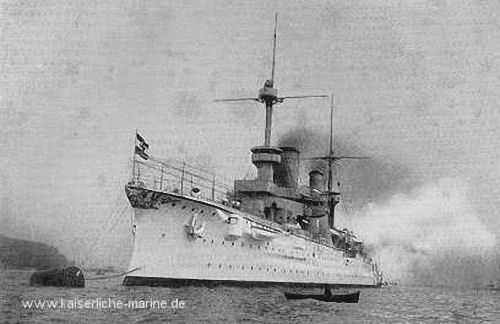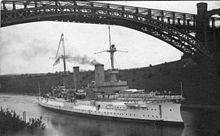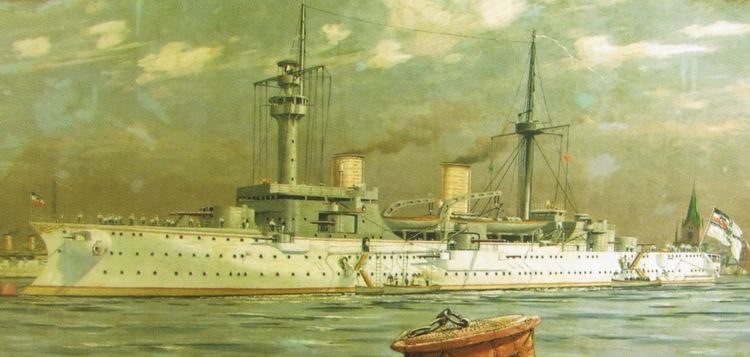Name Fürst Bismarck Laid down April 1896 Struck 17 June 1919 Construction started April 1896 Length 127 m | Commissioned 1 April 1900 Fate Scrapped in 1919–1920 Launched 25 September 1897 | |
 | ||
SMS Fürst Bismarck (Prince Bismarck) was Germany's first armored cruiser, built for the Kaiserliche Marine before the turn of the 20th century. The ship was named for the German statesman Otto von Bismarck. The design for Fürst Bismarck was an improvement over the previous Victoria Louise-class protected cruiser—Fürst Bismarck was significantly larger and better armed than her predecessors.
Contents

The ship was primarily intended for colonial duties, and she served in this capacity as part of the East Asia Squadron until she was relieved in 1909, at which point she returned to Germany. The ship was rebuilt between 1910 and 1914, and after the start of World War I, she was briefly used as a coastal defense ship. She proved inadequate to this task, and so she was withdrawn from active duty and served as a training ship for engineers until the end of the war. Fürst Bismarck was decommissioned in 1919 and sold for scrap.
Design

Fürst Bismarck was designed before the naval arms race between Germany and the United Kingdom. Admiral Hollmann was the State Secretary of the Naval Office at the time. Given the dominance of the British Royal Navy and the impossibility, as he saw it, of competing with it, Hollmann envisaged a small fleet consisting of torpedo boats and coastal defense ships to be based in German waters. This would be supplemented by a number of cruisers for overseas duties, including trade protection.

The first armored cruiser to be designed by the German navy, Fürst Bismarck was an enlarged version of the Victoria Louise-class cruisers, at nearly twice the displacement and with a significantly more powerful armament. The ship was intended for overseas use, particularly in support of German colonies in Asia and the Pacific. Despite heavy political opposition, the new ship was approved by the Reichstag, and was laid down as Ersatz Leipzig in April 1896 at the Imperial Dockyard in Kiel. Fürst Bismarck, named after the famous German chancellor Otto von Bismarck, was completed on 1 April 1900, at a cost of 18,945,000 Marks.
Dimensions

Fürst Bismarck was 125.70 m (412.4 ft) at the waterline, with an overall length of 127 m (417 ft) and a beam of 20.40 m (66.9 ft). She had a draft of 7.80 m (25.6 ft) forward and 8.46 m (27.8 ft) aft. She displaced 10,690 tonnes (10,520 long tons) at the designed load, and 11,461 tonnes (11,280 long tons) at full load. Fürst Bismarck was described as being a very good sea-boat, and was highly responsive to commands from the helm. However, the ship suffered from serious roll problems and heavy vibration at higher speeds. Her metacentric height was .72 m.
The ship was of transverse and longitudinal steel frame construction; the hull was a single layer of wooden planks covered by a Muntz metal sheath that extended up to .95 m (3.1 ft) above the waterline. The lower portions of the ship, including the stem and the stern, were covered with bronze plating. The ship had 13 watertight compartments and a double bottom that ran for 59% of the length of the hull.
Machinery
Fürst Bismarck was propelled by three vertical four-cylinder, triple-expansion reciprocating engines. The engines were powered by four Thornycroft boilers—which had been built by AG Germania—and 8 cylindrical boilers. The Thornycroft boilers had two fire boxes apiece, for a total of eight, while the cylindrical boilers each had four fire boxes, for a total of 32. Each of the three engines drove a three-bladed screw. The center propeller was 4.40 m (14.4 ft) in diameter, while the two outer screws were slightly larger, at 4.80 m (15.7 ft) in diameter. The engines produced 13,500 ihp (10,100 kW) and a top speed of 18.7 knots (34.6 km/h). On trials, the engines were pushed to 13,622 ihp (10,158 kW), but still only provided a top speed of 18.7 knots (34.6 km/h). Electrical power was supplied by five generators that provided 325 kilowatts at 110 volts.
Armor
Fürst Bismarck was protected with Krupp armor, which was in some cases thicker than that of subsequent designs. The armor belt was 20 cm (7.9 in) thick in the central portion of the ship, and tapered down to 10 cm (3.9 in) towards either end of the ship. Set behind the armored belt were 10 cm (3.9 in) thick shields for critical areas of the ship. The main armored deck was 3 cm (1.2 in) thick, with 5 cm (2.0 in) thick slopes. The forward conning tower had 20 cm-thick sides and a 4 cm (1.6 in) thick roof, while the aft conning tower had 10 cm sides and a 3 cm roof. The main battery turret sides were 20 cm thick and the roofs were 4 cm thick. The 15 cm turrets had 10 cm sides and 7 cm (2.8 in) gun shields. The casemated guns had 10 cm shields.
By contrast, the following armored cruiser design, Prinz Heinrich, had only had a 10 cm-thick armor belt and 15 cm (5.9 in) of armor on the turret sides. Even Blücher, Germany's last armored cruiser, only had a 18.0 cm (7.1 in) armored belt and 18 cm-thick turret faces, though her overall scale of protection was much more comprehensive than Fürst Bismarck's.
Armament
Fürst Bismarck's main armament consisted of four 24 cm (9.4 in) SK L/40 quick-firing guns in two Drh. L. C/98 twin turrets, fore and aft of the main superstructure. These guns could depress to −4 degrees and elevate to 30 degrees, for a maximum range of 16,900 m (18,482 yd). The guns fired 140 kg (309 lb) armor-piercing shells at a muzzle velocity of 690 meters per second (2,300 ft/s). The propellant charge weighed 41.35 kg (91 lb) and was stored in a brass case. The ship stored 312 rounds, for a total of 78 shells per gun.
The secondary armament consisted of twelve 15 cm (6 in) SK L/40 quick-firing guns in MPL type casemates, and ten 8.8 cm (3.5 in) SK L/30 guns in a combination of casemates and shielded mounts. The 15 cm guns could elevate to 20 degrees, and had a range of 13,700 m (14,983 yd). The 15 cm guns could sustain a rate of fire of 4 to 5 rounds per minute, and stored 120 shells per gun. The 8.8 cm gun fired a 10 kg (22 lb) projectile at a muzzle velocity of 590 m/s (1,900 ft/s). Each gun was supplied with 250 shells.
Six 17.7 in (450 mm) torpedo tubes were also fitted, with a total of 16 torpedoes. One tube was fitted to a swivel mount on the stern of the ship, four were submerged on the broadside, and the sixth was placed in the bow, also submerged.
Service history
Upon commissioning, Fürst Bismarck was assigned to the German East Asia Squadron. She arrived at Tsingtao in August 1900, under the command of Konteradmiral (Rear Admiral) Curt von Prittwitz und Gaffron, and participated in the suppression of the Boxer Rebellion. The ship won the Kaiser's gold challenge cup for heavy-gun marksmanship in 1901 and 1903. When the new armored cruiser SMS Scharnhorst arrived at Tsingtao in 1909 to replace Fürst Bismarck as flagship of the East Asia Squadron, she was ordered back to Germany. Upon arriving in Kiel in June 1909, she was decommissioned and entered a lengthy modernization that lasted until 1914.
At the outbreak of World War I, the ship was reactivated for coast defense duties, but was quickly withdrawn from active service. Fürst Bismarck spent the remainder of the war as a stationary accommodation and engineering training ship in Kiel. In 1919, she was used for a short time as an office ship. Fürst Bismarck was struck from the navy register on 17 June 1919, sold for scrap, and broken up the following year at Audorf-Rendsburg.
